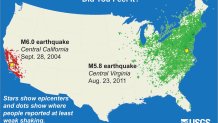It was Shomari Stone's first day on the job at NBC4.
"I was shadowing Chris Gordon, and all of a sudden the car we were in started shaking, and I'm thinking they are playing a joke on me," Stone said. "Are they, like, shaking the car?"
On August 23, 2011, a 5.8-magnitude earthquake struck near Mineral, Virginia, about 80 miles southwest of D.C.
What Shomari and other people in the D.C. area felt was the "largest and most damaging earthquake that's happened in the eastern U.S. in over 100 years," U.S. Geological Survey scientist Thomas Pratt said.

"We’re pretty lucky that nobody got seriously injured or killed in that earthquake," he added.
Storm Team 4 Chief Meteorologist Doug Kammerer remembered the aftershocks.
"I was in bed," he said. "I’m literally waiting for the aftershocks because that’s what I do, and I remembered an aftershock at about two-thirty in the morning."
"And again, you just, you just feel the little shaking going on across the entire area," Kammerer said.
Millions in Damage
The total economic loss from the earthquake was an estimated $200 to $300 million.
The Washington Monument experienced some of the worst damage in the District because of its stone structure, with no steel and no metal reinforcement, said Mike Litterst, National Mall spokesman.
"The stone merely magnified those waves, all the way up to the top," Litterst said. "So of the damage we saw, the majority of it was from the 500-550 foot level."

The Washington National Cathedral also experienced damage, with the worst in the main central tower of the church, with huge pieces of stone shifted and rotated.
Joe Alonso, head stone mason at the cathedral, said all the energy from the earthquake went up the walls.
"I always say that quake lasted 58 seconds," Alonso said. "Had it lasted two or three more seconds, we would have had a tremendous amount more damage."
Repairs have been done at the cathedra for the past 10 years. Alonso estimated the earthquake caused about $34 million in damage. So far, they've completed about $17 million in repairs.

"We raise some money, we fix something, we raise a little more money, we fix something else," he said. "It's kind of pay as you go."
Earthquakes on the East Coast?
UCGS' Pratt said the reason for earthquakes on the East Coast is a bit of a mystery because there are no plate boundaries nearby, as they are in the western U.S. Most earthquakes occur along plate boundaries, where plates scrape against each other.
"It's a scientific question as to why we get earthquakes within the plate boundaries rather than at the edges. And we don't know the answer to that," Pratt said.
Earthquakes on the East Coast are felt differently than those that occur in the west.

"Eastern U.S. earthquakes are felt much more widely that the western U.S. because the rocks in the continent are much colder, they’re much older and they’re much stronger," Pratt said. "So the energy gets transmitted much more effectively."
Damage from earthquakes can extend to farther distances in the eastern U.S.
"I have this brick to remind myself that this actually happened in the District of Columbia, Maryland, Virignia. Everyone felt this earthquake," Stone said.

"To be able to report on it on your first day at NBC Washington is extraordinary," he added.

